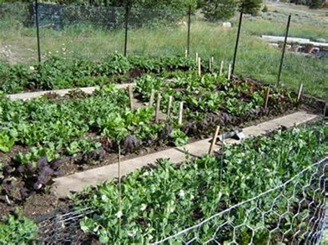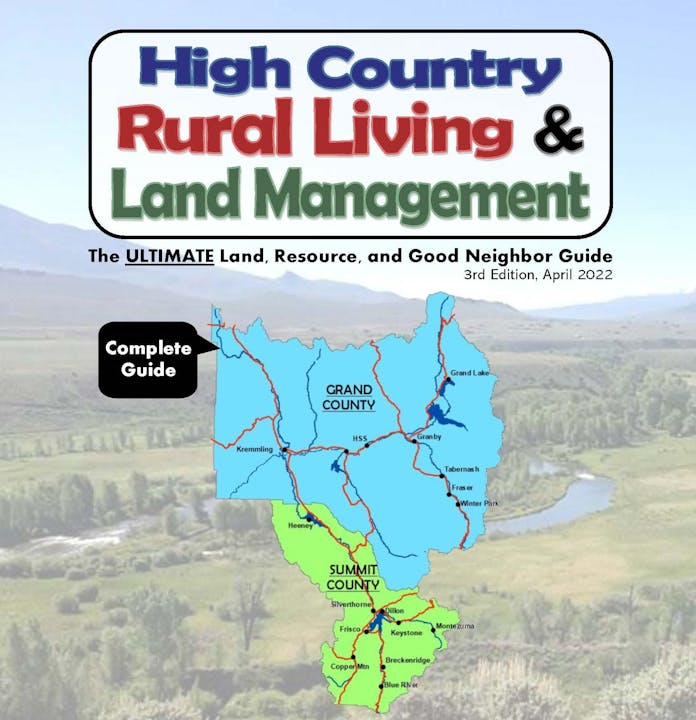Gardening in the High Country

ON THIS PAGE
- Soil Properties
- Short Growing Seasons
- Extreme Weather Fluctuations
- On the Bright Side
- What to Grow
- Community Gardens
- Food Preservation
Gardening in the Colorado mountains presents a unique set of challenges. Temperature, intense sunlight, low humidity, short growing seasons, desiccating winds, extreme weather fluctuations, infertile soils, recurrent drought, and wildlife damage all present challenging conditions for growing plants in the high country.
Soil Properties
Common soil issues include: poor aeration, low organic matter and nutrients, and rocky soils. Some soils also have a high pH that can create nutrient deficiencies in plants. Colorado soils are often high in iron, but the yellowing symptom of iron deficiency occurs because high calcium concentrations in the soil “tie up” the iron and make it unavailable to growing plants.
With that being said, you can:
- Plant in raised beds or containers
- Choose varieties that will grow well with existing soil conditions
- Select species that will improve the soil qualities
Short Growing Seasons
Growing seasons tend to be shorter at higher elevations. Lower valley floors often have even shorter seasons due to cold air sink from surrounding mountains. The air drainage phenomenon can also make a difference when determining the location of your garden. Avoid placement of hedges, fences, and other landscape features that may obstruct airflow. Cool nighttime temperatures also delay the maturity of vegetables and flowers.
Extreme Weather Fluctuations
It is not uncommon for mountain communities to have an already short growing season interrupted by a “killing” frost. The real plant killers, however, are the infrequent (but rapid) changes in temperature. Temperature swings can leave scars on trees and shrubs and serve to eliminate many plants with borderline hardiness. Heavy, wet snows can also occur in spring and fall. When this happens, trees, shrubs, and garden flowers may be caught in full leaf or peak bloom. These snows, known as “limb-breakers”, often cause physical damage that increases a plant’s susceptibility to insects and diseases.
On the Bright Side
The high intensity sunlight in the mountains produces stronger stems and brighter flowers. The short growing season and cooler temperatures also extend the growing season for “cool-season.” Additionally, thanks to Colorado’s semi-arid climate, there are fewer insect and disease problems. By carefully selecting suitable plant species and using microclimates to your advantage, you can grow a successful and colorful garden of flowers, vegetables, trees, and shrubs.
What to Grow
Perhaps the most common question from new gardeners is “What can I grow here?” The answer is “cool season vegetables.” Most seed packets will make the distinction between warm season and cool season vegetables. A general rule of thumb is that warm season vegetables don’t like temperatures below 50°F (and most of our summer nights drop below 50°F). As such, warm season veggies are likely to only do well if they are in a greenhouse or inside your home on your windowsill. Examples of warm season vegetables include tomatoes, peppers, squash, and basil.
Cool season vegetables are easier to grow and more successful in Middle Park. Green leafy vegetables, root vegetables, and some peas are most notable for their viability in the high country. Lettuce, spinach, kale, swiss chard, arugula, bok choy, radishes, carrots, beets, parsnips, turnips, onions, snow peas, and sugar snap peas are some of the veggies that flourish in our climate.
When buying seeds, remember to make sure you are buying “cold season” varieties. You should also check the amount of time the vegetable needs to reach maturity. Why does this matter? We have a very short growing season in Grand and Summit Counties, so you are wise to choose veggies that grow quickly. Some areas of Middle Park have fewer than 25 frost-free days every year. That is NOT much time for vegetables to be ready for harvest. Accordingly, steer away from anything that needs more than 60-70 days to mature. Fortunately, most of these cool season vegetables can withstand a frost, so you do NOT have to panic every time it gets cold outside.
Perennial vegetables (like rhubarb, horseradish, chives, and asparagus) will come back year after year without much effort from you. The roots will need a year or two to get established, but, once settled, they will delight you for years to come.
Gardening Presentations
Veggie Gardening Class 2023Veggie Gardening Class #1 2016Veggie Gardening Class #2 2016CSU Extension also has some great resources for lawn and gardening. You might consider checking out these websites:
Yard and Garden: https://extension.colostate.edu/topic-areas/yard-garden/?target=publications
Low-Water Native Plants for Colorado Mountains: https://extension.colostate.edu/docs/pubs/native/MountainsSm.pdf
Alternative Pesticide Management for Lawn and Garden: https://extension.colostate.edu/docs/pubs/garden/xcm221.pdf
Certified Colorado Gardner Program—Colorado Master Gardener: https://cmg.extension.colostate.edu/certified-colorado-gardener/
PlantTalk Colorado (info on many horticulture topics): https://planttalk.colostate.edu/
Community Gardens
Grand County
www.grandcommunitygardens.org/
There are four community gardens in Grand County.
For Granby, HSS, and Kremmling beds, call CSU Extension at 970-724-3436.
For Fraser beds, contact Fraser Valley Rec at 970-726-8968.
- Granby, near Morales Park
- Hot Sulphur Springs
- Fraser, near the skating rink and ball fields
- Kremmling, adjacent to the Fairgrounds
Summit County
- Frisco, Nancy’s Garden — www.highcountryconservation.org/community-gardens
- Dillon, Leslie’s Garden — www.townofdillon.com/visit/community-garden
- Silverthorne, Silvana’s Garden — www.facebook.com/silvanascommunitygardens/
- Breckenridge Community Garden — https://highcountryconservation.org/community-gardens/
Food Preservation
If you are interested in learning more about Food Preservation at High Altitudes, contact the Grand or Summit CSU Extension Offices. They can provide you resources or set you up with a Food Preserving Class. Contact info for both offices is on page 3.
You can also checkout the link below from CSU Extension for factsheets on Food Preservation and Canning: https://extension.colostate.edu/topic-areas/nutrition-food-safety-health/
References: 1, 8, 37



